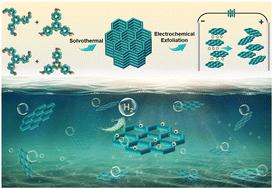当前位置:
X-MOL 学术
›
J. Mater. Chem. A
›
论文详情
Our official English website, www.x-mol.net, welcomes your feedback! (Note: you will need to create a separate account there.)
Electrochemically exfoliated covalent organic frameworks for improved photocatalytic hydrogen evolution
Journal of Materials Chemistry A ( IF 10.7 ) Pub Date : 2023-12-06 , DOI: 10.1039/d3ta06312g Ting Wang 1, 2, 3, 4 , Ruijuan Zhang 5 , Pengda Zhai 5 , Mingjie Li 1, 3, 4 , Xinying Liu 5 , Chaoxu Li 1, 3, 4
Journal of Materials Chemistry A ( IF 10.7 ) Pub Date : 2023-12-06 , DOI: 10.1039/d3ta06312g Ting Wang 1, 2, 3, 4 , Ruijuan Zhang 5 , Pengda Zhai 5 , Mingjie Li 1, 3, 4 , Xinying Liu 5 , Chaoxu Li 1, 3, 4
Affiliation

|
Covalent organic frameworks (COFs) have recently shown great prospects for their photocatalytic applications in solar-to-hydrogen conversion. Nevertheless, most of the COFs were synthesized as crystalline bulk powders, impeding the exposure of surface catalytically active sites. Developing a noninvasive and expedient route to exfoliate COFs in liquids still remains a great challenge. Herein, two typical 1,3,5-tri(thiophen-2-yl)benzene (TTB)-based COFs (one possesses non-donor–acceptor constitution, denoted as TTB-PB, while the other possesses donor–acceptor constitution, denoted as TTB-PT) were synthesized via Schiff-base condensation reactions. Subsequently, these bulk COFs were exfoliated via a facile electrochemical strategy in aqueous systems. The obtained exfoliated COFs can not only facilitate photo-triggered exciton dissociation but also afford more accessible active sites and enhanced hydrophilicity. Consequently, the exfoliated COFs exhibited much higher photocatalytic capabilities for H2 evolution from water in sharp contrast to their unexfoliated precursors. It is to be noted that the exfoliated donor–acceptor COFs achieved a maximum H2 evolution rate of 27.24 mmol h−1 g−1, which is superior to that of the exfoliated non-donor–acceptor COF (i.e., 9.86 mmol h−1 g−1), and also ranks at the top of the state-of-the-art thiophen-based COF photocatalysts in the literature. This work enriches the fabrication approach of COF exfoliation. Furthermore, utilizing the synergetic strategy of aqueous electrochemical exfoliation and suitable molecular design, TTB-based COFs demonstrate promising photocatalytic activity.
中文翻译:

电化学剥离的共价有机框架可改善光催化析氢
共价有机框架(COF)最近在太阳能-氢转化中的光催化应用显示出巨大的前景。然而,大多数COF都是作为结晶散装粉末合成的,阻碍了表面催化活性位点的暴露。开发一种非侵入性且便捷的方法来去除液体中的 COF 仍然是一个巨大的挑战。本文中,两种典型的1,3,5-三(噻吩-2-基)苯(TTB)基COF(一种具有非给体-受体结构,表示为TTB-PB,而另一种具有给体-受体结构,表示为TTB-PT)是通过席夫碱缩合反应合成的。随后,这些块状 COF 在水性系统中通过简单的电化学策略进行剥离。所获得的剥离COF不仅可以促进光触发激子解离,还可以提供更容易接近的活性位点和增强的亲水性。因此,剥离的COF表现出更高的从水中析出H 2的光催化能力,与其未剥离的前体形成鲜明对比。值得注意的是,剥离的供体-受体COF实现了27.24 mmol h -1 g -1的最大H 2释放速率,这优于剥离的非供体-受体COF(即9.86 mmol h - )。 1 g -1),并且在文献中也位居最先进的噻吩基COF光催化剂之首。这项工作丰富了COF剥离的制造方法。此外,利用水性电化学剥离和合适的分子设计的协同策略,基于TTB的COF表现出有前景的光催化活性。
更新日期:2023-12-06
中文翻译:

电化学剥离的共价有机框架可改善光催化析氢
共价有机框架(COF)最近在太阳能-氢转化中的光催化应用显示出巨大的前景。然而,大多数COF都是作为结晶散装粉末合成的,阻碍了表面催化活性位点的暴露。开发一种非侵入性且便捷的方法来去除液体中的 COF 仍然是一个巨大的挑战。本文中,两种典型的1,3,5-三(噻吩-2-基)苯(TTB)基COF(一种具有非给体-受体结构,表示为TTB-PB,而另一种具有给体-受体结构,表示为TTB-PT)是通过席夫碱缩合反应合成的。随后,这些块状 COF 在水性系统中通过简单的电化学策略进行剥离。所获得的剥离COF不仅可以促进光触发激子解离,还可以提供更容易接近的活性位点和增强的亲水性。因此,剥离的COF表现出更高的从水中析出H 2的光催化能力,与其未剥离的前体形成鲜明对比。值得注意的是,剥离的供体-受体COF实现了27.24 mmol h -1 g -1的最大H 2释放速率,这优于剥离的非供体-受体COF(即9.86 mmol h - )。 1 g -1),并且在文献中也位居最先进的噻吩基COF光催化剂之首。这项工作丰富了COF剥离的制造方法。此外,利用水性电化学剥离和合适的分子设计的协同策略,基于TTB的COF表现出有前景的光催化活性。







































 京公网安备 11010802027423号
京公网安备 11010802027423号